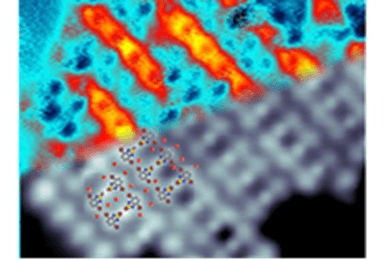Organic compounds offer a variety of functional properties eligible almost on demand. However, the application of organics into devices requires in addition excellent charge transport properties at energies larger than 2eV, where electronics works. Here, Barragan et al. show a mechanism enabling one-dimensional conductance-channels connecting discrete molecular states at 2.1eV through the pores of a metal-organic network on Cu(110).

Graphical representation of the conductance channels and the topographic structure that enables them. The molecular modeling of the 4,7-dibromobenzo[c]-1,2,5-thiadiazole (2Br-BTD) molecules on the copper surface is superposed: Br atoms are depicted as bright red dots in the sketch.
In the last decade, a considerable scientific attention has been devoted to the formation of ordered organic structures ensuring molecular functionalities and good electrical properties. In this context, a valuable approach was offered by Ullmann cross-coupling reactions where halogenated molecules catalyzed by metal surfaces promoted the synthesis of extended structures through the molecular polymerization. This chemical approach results in good mechanical and electrical contacts between components. In this collaborative work between the Donostia International Physics Center (DIPC), the University of the Basque Country (UPV/EHU) and CFM, the authors show that the electron conductance of benzothiadiazole molecules, extensively used in electronics, can be enhanced even before their polymerization. Indeed, despite the formation of a porous network, two adjacent, periodic and isoenergetic contributions, namely a molecular electronic resonance and the confined surface-state, sum-up forming one-dimensional conductance channels, observable in energy-resolved maps of a 2D-metal-organic network. Though they do not contribute directly to the conductance, the adsorption configurations of Br atoms, inorganic byproduct of the redox-reacted 4,7-dibromobenzo[c]-1,2,5-thiadiazole molecules on the copper surface critically control the channel continuity. These halogen atoms enable the delocalization of the molecular electronic resonance into a continuous channel acting on the confinement of the Cu(110) surface state on the pores. Small displacements of the Br atoms change the local surface potential misaligning the energy levels and creating discontinuity into the channels. This work opens new perspectives on charge-transport mechanisms controlled by an order-disorder transition determined by the movement of single atoms limiting carrier’s mobility in two-dimensional organic networks.




